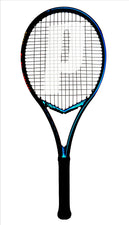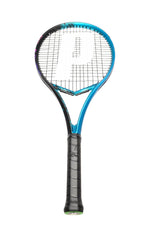Price Promise
Here at TennisHQ we're committed to providing all of our Tennis Players the most up-to-date pricing available. We review our prices weekly to ensure you're getting the best value service here with us.
Need Help? Email us on sales@tennishq.co.uk or give us a call on 02381 449449
Free UK Delivery (£75+)*
We offer rapid free UK mainland delivery on any order over £75. We also offer a UK Next Day service where needed. For details see: Delivery Info
Easy Returns
Need Help? Email us on sales@tennishq.co.uk or give us a call on 02381 449449
Shipping again from The 28th
Intermediate Tennis Rackets
As you advance in your tennis journey and transition from a beginner to an intermediate player, finding the right equipment becomes crucial to further develop your skills and take your game to the next level. Intermediate tennis rackets are specifically designed to cater to the needs of players who have gained proficiency in the fundamentals of the game and are ready to explore more advanced techniques. For tournament players we would advise tasking a look at our Advanced Tennis Rackets. In this comprehensive guide, we will delve into the key factors to consider when choosing intermediate tennis rackets, ensuring that you find the perfect racket to support your continued growth and success on the court.
How to know if you are a beginner, intermediate or advanced tennis player?
Determining your skill level as a tennis player can be subjective, but there are some general criteria that can help you assess whether you are a beginner, intermediate, or advanced player. Here are some factors to consider:
-
Technique: Beginners often struggle with the fundamental strokes like forehand, backhand, serve, and volley. Intermediate players have a decent grasp of these techniques but may still need refinement. Advanced players exhibit strong and consistent stroke mechanics with the ability to vary shot selection and pace.
-
Consistency: Beginners may struggle to consistently hit the ball over the net and keep it within the court. Intermediate players can maintain rallies and control the direction of their shots. Advanced players demonstrate excellent consistency and can maintain long rallies with a variety of shots.
- Match Experience: Beginners may have limited match experience and may find it challenging to adapt to different opponents and game situations. Intermediate players have played more matches, gaining experience and developing a better understanding of strategy and match management. Advanced players have extensive match experience, often competing at a high level.
- Competitive Level: Beginners typically play at a recreational level, participating in casual matches or local club leagues. Intermediate players may compete in club leagues or low-level tournaments. Advanced players often compete at a competitive level in tournaments, leagues, or college/university teams.
It's important to note that these are general guidelines, and every player's progression may vary. If you have decided your level may be closer to beginner then you should check out our Beginner Tennis Rackets.
How do I choose an intermediate tennis racquet?
-
Understanding Intermediate Tennis Rackets: Intermediate tennis rackets are designed to bridge the gap between beginner and advanced-level rackets. They offer a balance between control, power, and maneuverability, allowing players to refine their technique, generate pace, and exercise greater control over their shots. These rackets are typically characterized by a blend of performance-oriented features and player-friendly characteristics.
-
Racket Weight: One of the crucial considerations for intermediate tennis rackets is weight. Intermediate players generally benefit from a slightly heavier racket compared to beginners. Rackets in the weight range of 280 to 305 grams provide a good balance of stability, power, and control. The added weight helps generate more power and stability while still maintaining maneuverability.
-
Head Size: Head size plays a significant role in the performance of tennis rackets. Generally, intermediate rackets have a slightly smaller head size than beginner rackets, ranging from 98 to 105 square inches. This reduced head size allows for increased control, precision, and maneuverability, giving players the ability to execute more advanced shots with confidence.
-
Length and Grip Size: Intermediate tennis rackets typically come in standard adult lengths of around 27 inches. Finding the right grip size is crucial for comfort and control. Grip sizes typically range from G2, G3 and G4, with the larger numbers indicating larger grip sizes and it's advisable to try different sizes to find the one that provides a secure and comfortable grip.
-
Balance and Swing Weight: Balance and swing weight are important considerations when selecting intermediate tennis rackets. Players at this level often benefit from a slightly head-light or evenly balanced racket. This balance promotes maneuverability, allowing for better control and faster racket acceleration. A suitable swing weight ensures stability during shots and helps generate power and control.
-
String Pattern and Tension: Intermediate players have a range of options when it comes to string pattern and tension. A more open string pattern, such as 16x19, provides a balance between power, spin potential, and control. Players who prefer more spin may opt for a more open pattern, while those seeking greater control might lean towards a denser pattern such as 18x20. As for string tension, it is largely a personal preference, but a general range of 50-60 pounds is commonly recommended for intermediate players.
-
Frame Stiffness and Dampening: Intermediate tennis rackets often have a moderate level of frame stiffness to provide a good blend of power and control. The stiffness of the frame affects how much energy is transferred from the racket to the ball. Additionally, rackets with built-in dampening technologies help reduce vibrations and provide better comfort, minimizing the risk of arm fatigue and injury.
-
Material and Construction: The material and construction of tennis rackets contribute to their performance characteristics. Advanced materials such as graphite, carbon fiber, and composites are commonly used in these rackets to offer a combination of strength, stability, and responsiveness. The construction techniques employed, such as advanced moulding processes, enhance the overall performance and feel of the racket.
-
Player Feedback and Reviews: There is no best intermediate tennis racket, however insights from fellow players, coaches, or tennis communities can provide valuable information about the performance, durability, and overall satisfaction of specific racket models.
In conclusion, intermediate tennis rackets are tailored to meet the needs of players who have progressed beyond the beginner stage and are looking to enhance their skills and performance on the court. By considering factors such as weight, head size, length, grip size, balance, string pattern, frame stiffness, material, and player feedback, you can find an intermediate tennis racquet that supports your continued growth as a player. If you're still curious to know a little more then you should check out our Ultimate Tennis Racket Buying Guide. With the right racket in your hand, you'll be well-equipped to take your game to new heights and enjoy the exciting challenges that lie ahead in your tennis journey.
Filter By
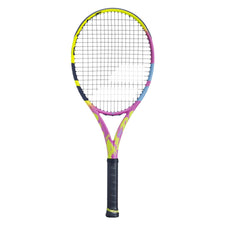
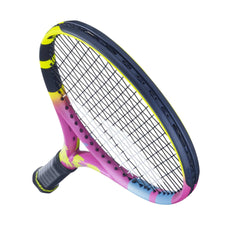

Babolat Pure Aero RAFA 2023 Tennis Racket - Yellow Purple Blue (Strung)



Babolat Boost Aero Rafa 2nd Generation Tennis Racket - Yellow / Pink / Blue
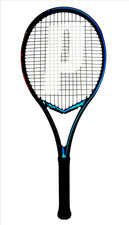
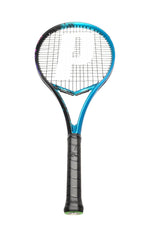

Prince Vortex 100 300g Tennis Racket - Black / Turquoise (Frame Only)
